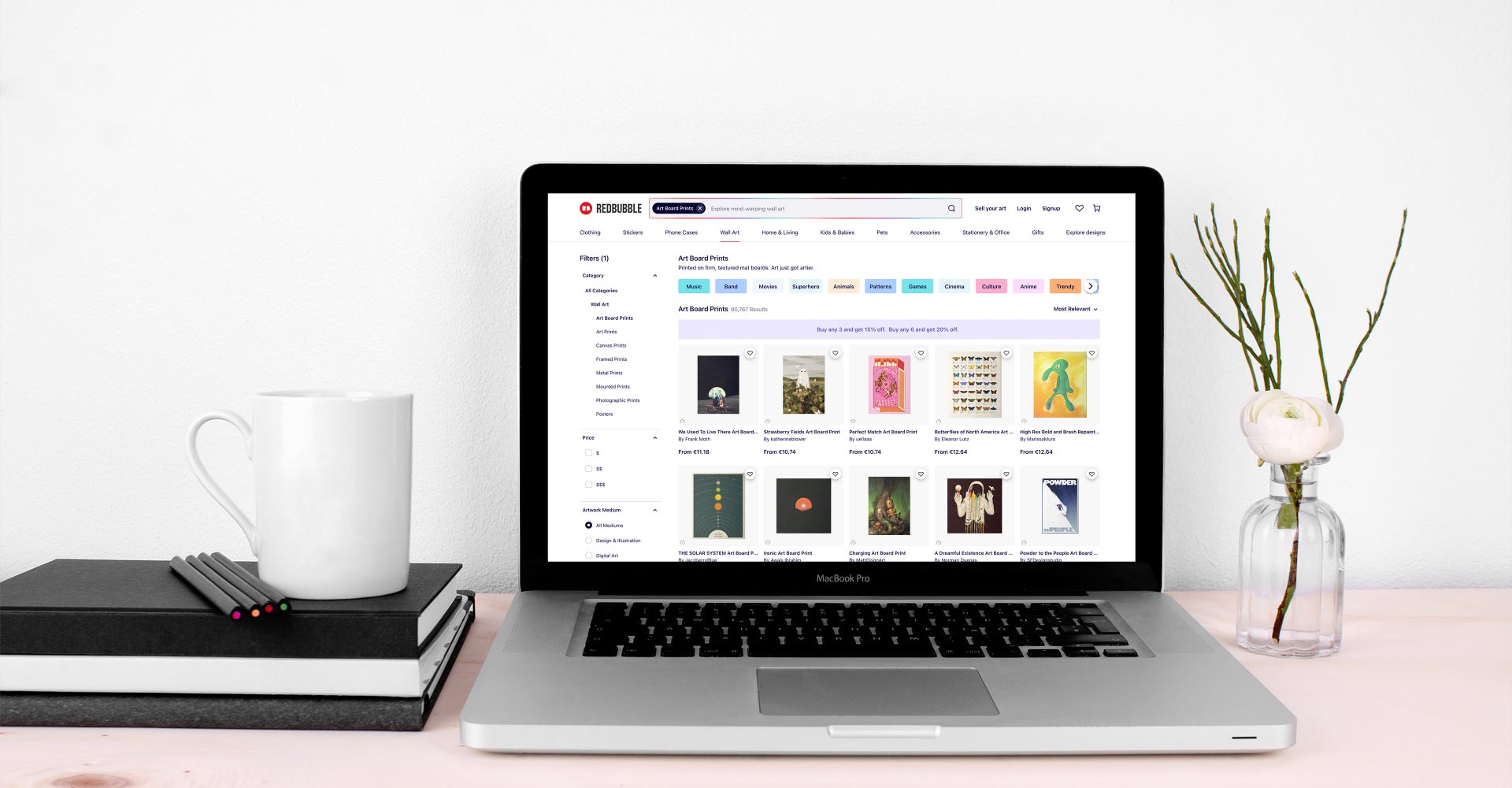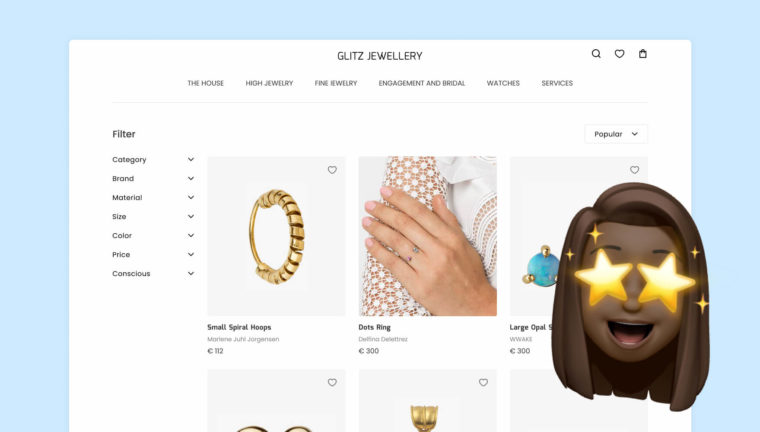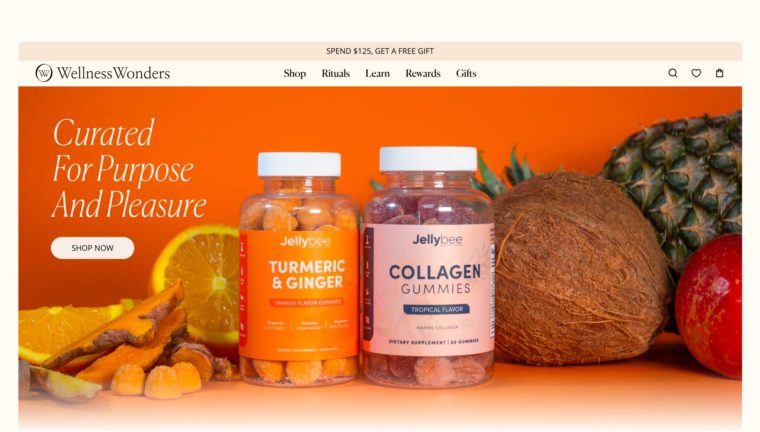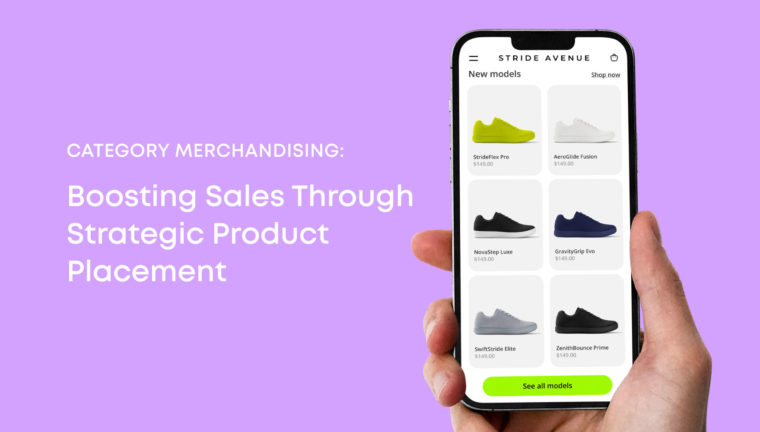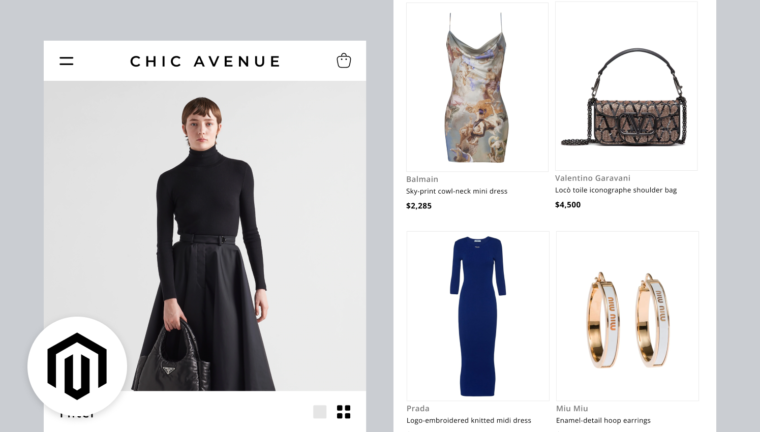If you own an online store and want to ensure its high sales, mastering eCommerce merchandising is a must. This concept is pretty broad and includes many essential elements, each of which you must take care of. However, we won’t be able to cover them all in just one article. Therefore, for now, we decided to focus on effective product category pages and their role in driving conversions.
But let’s start in order and go over the basics first so that you understand why we attach great importance to this topic. Of course, we won’t stop at theory and will give you a lot of valuable tips too. By putting them into practice, you’ll create an advanced online merchandising strategy for category pages and boost your sales.
Basics of E-commerce Merchandising

Before discussing what makes a good eCommerce category page, let’s review the online merchandising concept itself.
At its core, eCommerce merchandising is based on the strategic process of presenting and promoting products online to increase sales and customer loyalty.
Regarding online stores, merchandising is primarily about creating a visually appealing, shopping-stimulating, and easy-to-use catalog with well-optimized category pages. The goal is to encourage customers to buy more and leave them with a positive shopping experience. That’s why it’s crucial to improve your catalog and optimize category pages with advanced online merchandising techniques.
Key Elements of Advanced Online Merchandising:
Product categorization and organization.

It would be best to start by correctly categorizing and organizing the products in your catalog. This involves creating clear and logical categories and subcategories to help customers find what they are looking for most conveniently and quickly.
P.S. Later on, we’ll tell you how to optimize your category pages for SEO and other criteria that Google finds essential. For now, remember that effectively grouping items and ensuring a seamless browsing experience requires understanding your target audience and their preferences.
These and other topics we’ll detail in due course, so don’t stop reading.
Product imagery and descriptions

Since online shoppers can’t physically test your product, they must have other assessment options. That’s where high-quality product images and informative descriptions would come in handy: pictures will help customers visualize the item, and descriptions will provide them with essential details and specifications.
P.S. Including multiple images from different angles and incorporating customer reviews can also enhance trust and confidence in your product. That’s why eCommerce market leaders are always following this rule aiming to improve a category page’s ranking and make the shopping experience next to perfect.
User experience and navigation

Be aware of the user experience and easy navigation, too, as these aspects significantly affect the likelihood of purchasing.
Consider the following in this regard:
- Your online catalog should have a clean, intuitive design, easy-to-use filters, and optimized category-specific sorting options.
- Quick loading period and mobile responsiveness will make your online store more user-friendly by ensuring a seamless browsing experience across devices.
- Use personalized recommendations and related products, increasing cross-selling and upselling opportunities.
The Power of Category Page Optimization
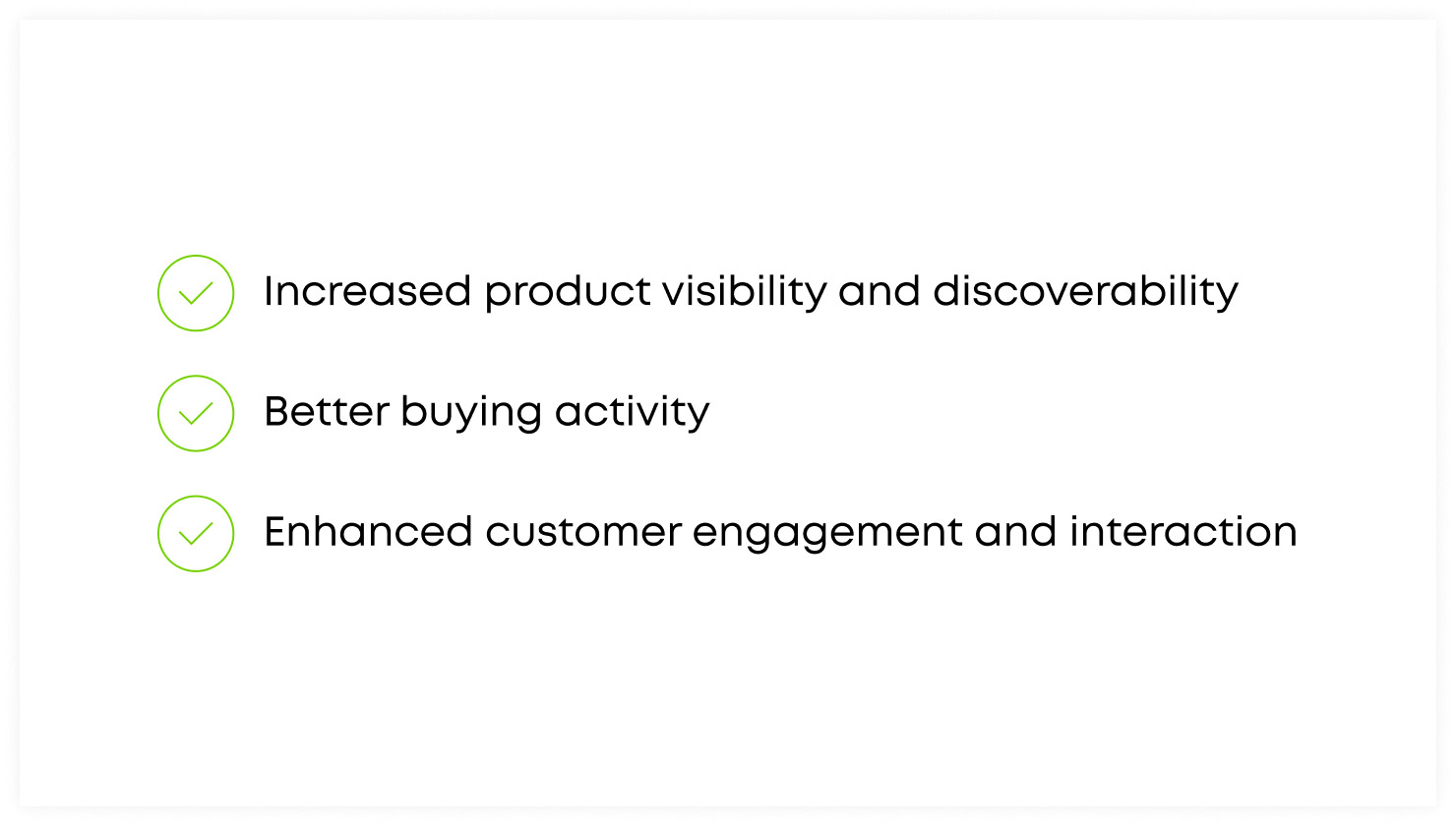
Category pages organize products into logical groups, such as clothing, electronics, or home decor. By doing so, you streamline the navigation of your online store, which results in customers quickly finding the desired item. In other words, a good product category page improves their shopping experience and stimulates buying activity.
Let’s clarify this point so as not to sound unreasonable.
Category Pages & Customer Behavior
Studies show that consumers often start their online shopping journey by browsing category pages. And the better these pages are structured, the more likely you are to turn a random visitor into an actual buyer.
Therefore, don’t let things go on their own: pay attention to the design of your catalog and, in particular, the way you group your products within it.
Benefits of Improving Category Page Optimization:

- Increased product visibility and discoverability. By utilizing strategic merchandising techniques, businesses highlight specific products, promotions, or new arrivals. This ensures that customers are aware of all the available options within a category, leading to potential sales.
- Better buying activity. Effective product category pages appealingly present relevant items, capturing customers’ attention and guiding them toward purchasing.
- Enhanced customer engagement and interaction. By incorporating interactive elements such as filters, sort options, and personalized recommendations, businesses provide a tailored browsing experience. Such a level of personalization not only elevates customer satisfaction but also improves conversion rates as customers find products that align with their preferences.
The benefits of optimization are clear now, but how do you achieve your goal? How to optimize category pages for conversions and, ultimately, sales?
Strategies for Creating Successful Product Category Pages
There are many approaches to ensure stable conversions and sales growth, and you’re welcome to choose which one to use. But if you don’t have a well-established strategy yet or don’t mind improving it, we suggest you look at what we offer you in our blog piece.
We’ve selected a few simple and effective practices guaranteed to get you highly targeted results in the shortest period. By following them, you can easily optimize the category page of your choice according to the needs and preferences of your customers.
In-depth Analysis of the Target Audience

We’ve already mentioned the importance of knowing your target customers: what are they fond of? What lifestyle do they lead? How to stimulate them to buy more and choose your online store?
If you can answer these and other similar questions with 100% certainty, feel free to move on to the next point of our suggested best practices for category pages. Otherwise, it’s time to conduct a deep analysis of your target audience, focusing on three main criteria:
- Demographic and geographic data
- Income level
- Main preferences and buying patterns
The obtained information will guide your design decisions: by creating personas representing your typical customers, you can organize your category pages to suit their usual online behavior.
Let’s discuss this matter in more detail.
Category Page Design

Successful product category pages are those that give the customer the best possible shopping experience, which starts with effective UI/UX design. To create one, you have to consider the following:
- Clear and intuitive navigation to help customers easily find what they are looking for. Use categories, subcategories, and filters to simplify the browsing process.
- Consistent branding and visual aesthetics across all category pages. This helps in creating a cohesive and professional look and building trust and familiarity with your brand.
- Effective use of product filters and advanced product sorting on category pages, resulting in improved user experience and increased chances of conversion.
By the way, we’ll soon show you a valuable online merchandising solution to automate your work with eCommerce category pages. You can convert your catalog into a real sales tool by introducing it into your business processes.
Product Visualization & Information

Another tip to improve a category page’s ranking involves properly presenting your products to the buyer. The goal is to get them interested in your items and convince them to choose your online store among all the available options.
We advise you to pay attention to several critical points in this regard:
- High-quality product images that accurately represent your products. Photo content for category pages plays a key role in captivating customers, as most people are visuals.
- Engaging product descriptions that highlight the unique features and benefits of each item. Use persuasive language and focus on the value proposition to encourage customers to make a purchase.
- User-generated content, including customer reviews and ratings. that builds trust and credibility. Positive reviews can significantly impact purchasing decisions and improve the overall perception of your products.
Category Page SEO Optimization
It’s not enough to create compelling content for your online store. You should also optimize your category pages for SEO to make Google more willing to display them to your customers when they search the web.SEO improvement consists of many aspects, such as updating content, adding relevant keywords, working on the semantic core, etc. And since this kind of work is never-ending and requires constant attention and high expertise, it is better to entrust it to professionals. They’ll take over category page SEO optimization and help lift your online store in the search results.
Cross-Selling & Upselling Techniques

Among techniques for improving category page optimization are such highly effective options as cross-sells and upsells. To be precise, it’s about the following:
- Limited-time offers and discounts. Promote limited-time offers and discounts on your eCommerce category pages to create a sense of urgency and drive impulse purchases. Such a strategy can also help you move slow-selling products or clear out excess inventory.
- Related product recommendations. Display related products on your category pages to encourage customers to explore additional options. Who knows, maybe they’ll buy more things than originally planned!
- Bundling and product associations. Create bundles or associations between complementary products to offer customers added value and convenience.
All this may sound complicated and time-consuming but don’t worry: we know the perfect solution to your problem. Perhaps it’s time to spill the beans and discuss the issue at length.
Tools and Technologies for Advanced Online Merchandising
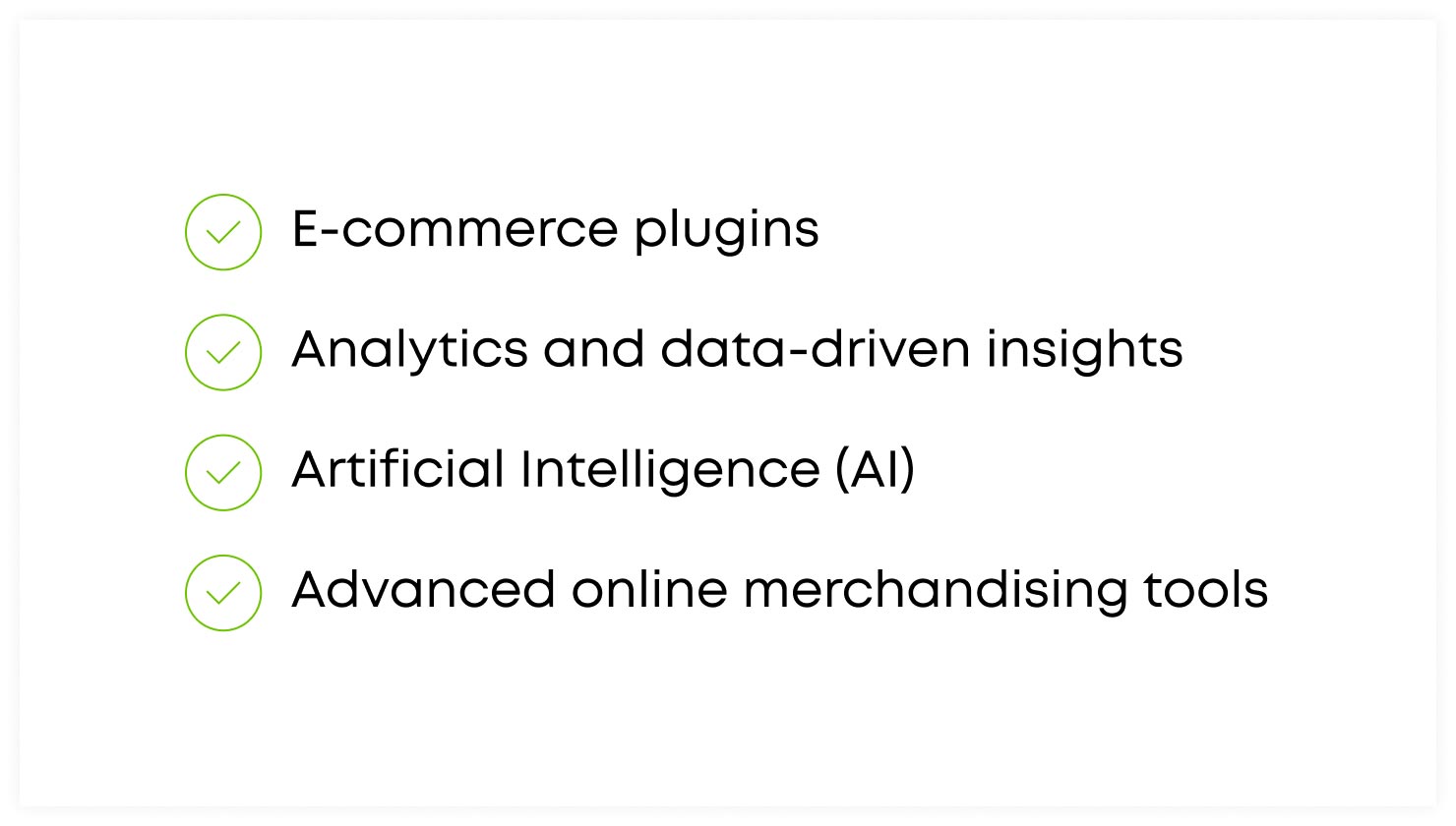
Today, the world is actively digitizing, which implies, among other things, the automation of routine processes and repetitive tasks with innovative solutions. So don’t hesitate to include some of the modern digital tools in your advanced online merchandising strategy for category pages.
Here are just a few examples of such tools.
E-commerce features and plugins
Many e-commerce platforms, including Shopify, WooCommerce, and Magento, offer features and plugins that help to manage online stores most efficiently.
Analytics and data-driven insights
There are a lot of cool solutions for tracking customer behavior and user preferences. This data will come in handy for personalized merchandising.
Artificial Intelligence (AI) and machine learning applications
Using these apps, you’ll be able to provide your customer with AI-powered product recommendations.
Advanced online merchandising tools
Easy to implement and use, these tools will lead you to higher conversions. Their striking example is Sortler, which we’ve already mentioned in passing. Now the time has come to discuss it in more detail.
Sortler

If you’re looking to optimize category pages with advanced online merchandising, Sortler is the way to go. It’s a great cloud-based tool that provides round-clock access to a manageable virtual catalog, which you can synchronize with the real one whenever you need. Its main advantage is the ability to create special automated rules for managing product placement on ecommerce category pages. More importantly, these rules will be executed independently without your constant participation.
Sortler helps you deal with the following:
- Improved product placement. You can define criteria that affect the visibility of particular items in your catalog. Sortler will automatically move them up or down the page based on your chosen factors, like seasonality, availability, variety, etc.
- Managing the balance of goods. Ask Sortler to automatically move unavailable items down the catalog and highlight those that run out if you want to sell them faster.
- Advanced cross-selling & upselling options. Use Sortler to create beautiful matching combinations and place them on the page in the quantity you need. For example, a jewelry store may show a ring and earrings from the same collection next to each other, encouraging the customer to make an additional purchase.
- Dealing with low-selling products. One of the most impressive Sortler’s features is the opportunity to improve the sales of underperforming products. The strategy is simple yet effective: have Sortler push those positions higher up the page, making them more visible to the customer, and assign a discount to them if things don’t improve within the specified time.
- Drag & Drop feature. And finally, freely move the products around the catalog page as you please to immediately see the result of your actions. Sometimes this is the most convenient way to work with a catalog.
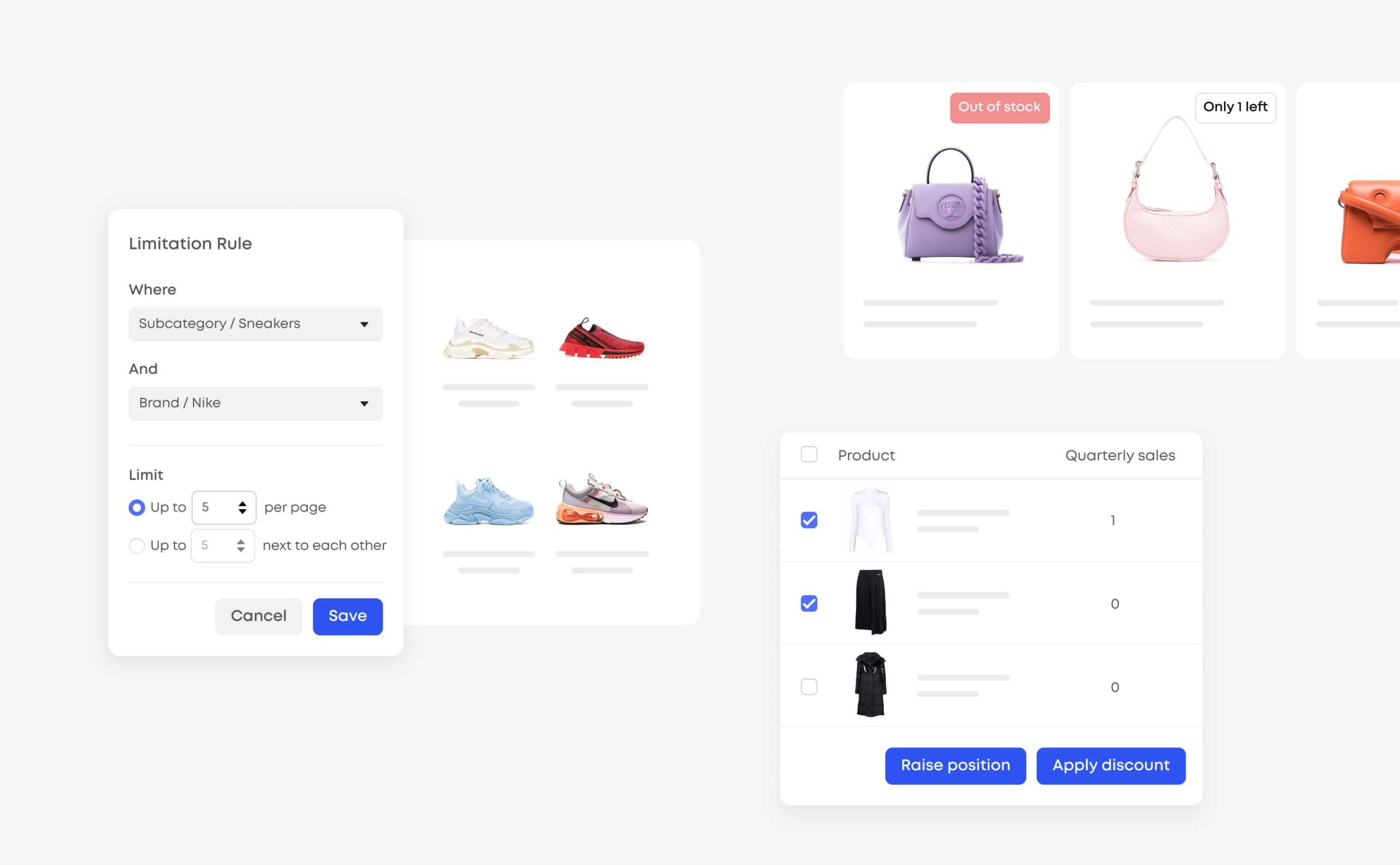
And that’s only a part of Sortler’s features helping to manage your catalog and optimize the category pages. Read more in another blog post.
Real-life Best Practices for Category Pages
We’ll also give some examples of successful product category pages and show how their experience will help you improve your e-commerce merchandising strategy.
Store A: XYZ Fashion
XYZ Fashion has created a visually appealing and user-friendly category page experience. They have incorporated high-quality product images, concise product descriptions, and easy-to-use filters that allow customers to narrow down their search. Additionally, they have strategically placed customer reviews and ratings, building trust and social proof.
Key Takeaway: Invest in high-quality product images, concise descriptions, an optimized category-specific sorting system, and user-friendly filters to enhance the visual appeal and usability of your category pages.
Store B: ABC Electronics
Another example of best practices for category pages is ABC Electronics. They have taken a different approach and implemented a personalized recommendation system based on previous customer purchases and browsing history. This strategy encourages shoppers to discover new products that align with their interests and preferences.
Key Takeaway: Implement a personalized recommendation system to boost cross-selling and encourage customers to explore new products.
Store C: LMN Home Decor
LMN Home Decor has successfully leveraged social media integration on their category page. They showcase user-generated content, such as customer photos and reviews, along with the option for shoppers to share products on their social media platforms. This strategy not only increases engagement but also amplifies brand visibility and generates additional traffic from social media channels.
Key Takeaway: Integrate social media elements on your category page to drive engagement, increase brand visibility, and generate additional traffic.
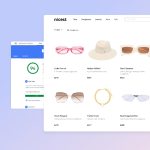
Thinking of starting your own online store or improving the existing one? Read 5 top tips in this regard. Follow the link right away and find out what you should take care of first.
Hopefully, our tips will help you optimize category pages for conversions and lead to more sales. And if you want to stay abreast of the latest developments regarding e-commerce experience, follow our blog since we often share valuable tips with the readers.
